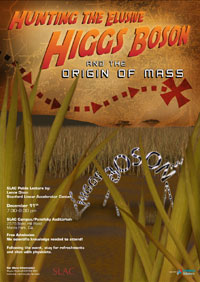

Tuesday - December 11, 2007
SLAC Today is available online at:
http://today.slac.stanford.edu
In this issue:
Public Lecture: Hunting the Elusive Higgs Boson
Safety Today: In Case of Emergency
Uwe Bergmann Demystifies X-Rays
 |
 |
|
Tuesday - December 11, 2007 |

Image courtesy of SLAC InfoMedia
Public Lecture:
|
||
|
|
||

In Case of Emergency
The ICE program was conceived in the mid-2000s and promoted by British paramedic Bob Brotchie. Brotchie found that when he arrived on the scene of accidents, his patients often had cell phones but he didn't always know which number to call. He thought it would be a good idea to create a nationally recognized name to identify the emergency contact person. Emergency service personnel and hospital staff can quickly reach the right emergency contact by simply dialing the number stored as "ICE." For more than one contact name, you can simply enter ICE1, ICE2 and ICE3. |
Uwe Bergmann Demystifies X-Rays
This winter, explore the science and applications of this fascinating form of light with Stanford Synchrotron Radiation Laboratory (SSRL) Senior Staff Scientist Uwe Bergmann. Bergmann will be teaching a five-week Stanford Continuing Studies course called "The World Under X-ray Vision," beginning on January 9, 2008. "I'd like to introduce how we can use x-rays to learn about the world, and in particular about nature," said Bergmann. "I want to keep it very general, and it doesn't require any special background in the sciences." Bergmann has worked with x-ray imaging since 1990 and is currently developing novel synchrotron based x-ray techniques. This will be his first Continuing Studies course, although he taught as a graduate student and gave a Cantor Arts Center public lecture last year. "I'm quite excited about the course," he remarked. "I've always liked the idea of giving lectures to general audiences." Read more... |
Events (see all | submit)
Access (see all)
Announcements
|
| | ||
|
|
||
 <%
Response.AddHeader "Last-modified", getArticleDate()
'Response.AddHeader "Last-modified","Mon, 01 Sep 1997 01:03:33 GMT"
'Monday, December 06, 2010
%>
<%
Response.AddHeader "Last-modified", getArticleDate()
'Response.AddHeader "Last-modified","Mon, 01 Sep 1997 01:03:33 GMT"
'Monday, December 06, 2010
%>View online at http://today.slac.stanford.edu/ |
||